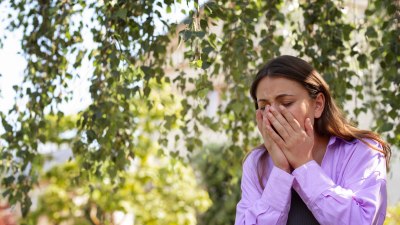When the Weather Feels Perfect but Your Allergies Disagree
Explore the challenges of enjoying ideal weather while managing allergies. Tips and insights for allergy sufferers.

The beauty of nature often invites us outdoors, particularly when the weather feels perfect. Sun shines brightly, temperatures are just right, and a gentle breeze sways the trees. However, for many, this idyllic scene can be marred by the onset of allergies. Pollen, dust, and other allergens can transform a perfect day into a battle for breath and comfort. This contradiction—feeling the urge to enjoy the beautiful weather while dealing with allergy symptoms—captures the essence of the struggle faced by millions. In this article, we’ll explore why allergies flare up in seemingly perfect weather, identify common allergens during different seasons, and provide practical tips to alleviate symptoms. Understanding the relationship between weather and allergies is essential for maintaining a quality outdoor experience, even amidst allergy challenges.
Allergies are increasingly common and can significantly impact one's quality of life. According to the Asthma and Allergy Foundation of America, more than 50 million Americans experience various types of allergies each year. Whether it’s seasonal changes, environmental triggers, or reactions to animals, the spectrum of allergens is vast. Interestingly, weather plays a significant role in the severity and prevalence of these allergies. On temperate days, pollen counts often skyrocket, especially from flowering plants and grasses that flourish in spring. Consequently, many who are allergic to these particles find themselves confined indoors, battling symptoms rather than enjoying the beautiful landscape that beckons them outdoors.
Understanding Allergens
Pollen is a primary culprit when it comes to seasonal allergies. Trees, grasses, and weeds release tiny grains into the air, triggering hay fever in susceptible individuals. Spring ushers in the flowering of trees like birch, cedar, and oak, flooding the air with pollen. As we transition into summer, grasses take center stage, while ragweed emerges in late summer and persists through fall. The amount of pollen can vary significantly with weather conditions. For instance, warm and dry conditions allow for greater pollen dispersal, whereas rain can temporarily wash away pollen, providing brief relief. However, following a rain shower, plants can rebound vigorously, producing even higher pollen counts shortly thereafter. Therefore, understanding these patterns can help allergy sufferers prepare and mitigate their reactions.
Common Allergy Symptoms
Allergy symptoms can range from mild to severe and often include sneezing, runny or stuffy nose, itchy eyes, and coughing. In some individuals, allergies can exacerbate asthma, leading to more serious respiratory symptoms like wheezing and difficulty breathing. While the symptoms may vary, they often strike at the most inconvenient times. For example, a picnic in the park or a day at the beach can be utterly compromised if sneezing fits or itchy eyes dominate the experience. This can lead to frustration and a reluctance to participate in outdoor activities during peak allergy seasons.
Managing Allergies in Perfect Weather
Fortunately, several strategies can empower individuals to enjoy beautiful days despite allergy challenges. Firstly, closely monitoring pollen forecasts can serve as an excellent tool for planning outdoor activities. Websites and apps dedicated to allergy tracking can provide real-time updates, allowing individuals to select days with lower pollen counts for outdoor excursions.
Another effective strategy for managing allergies is timing outdoor activities appropriately. Pollen counts tend to be highest in the morning, particularly between 5 a.m. and 10 a.m. Opting for afternoon or evening activities can help reduce exposure to allergens. Additionally, participating in outdoor events after rain can provide some relief, as moisture temporarily lowers pollen levels.
Protective Measures
For those prone to allergies, consider incorporating a few protective measures. Wearing sunglasses can shield the eyes from airborne allergens, while masks can filter out pollen particles. When returning home after being outside, showering and changing clothes can dramatically reduce the number of allergens brought into the house. Keeping windows closed during peak pollen times also helps prevent allergens from entering living spaces.
Medications and Treatments
Various over-the-counter medications can help alleviate allergy symptoms. Antihistamines can reduce sneezing, runny nose, and itching, while decongestants can assist with nasal congestion. Additionally, nasal sprays and eye drops specifically designed for allergy relief can offer targeted comfort. For chronic allergy sufferers, consulting with an allergist about personalized treatment plans, including possible immunotherapy, can lead to long-term relief.
Pollen Count Awareness
Awareness of the local pollen count provides valuable insight into daily activity planning. Many weather services report pollen counts alongside traditional weather forecasts. Monitoring these predictions allows individuals to navigate their schedules proactively. If pollen is particularly high, engaging in indoor activities or practices like yoga, reading, or arts and crafts can provide enjoyable alternatives without triggering allergic reactions.
The Role of Indoor Air Quality
Moreover, maintaining excellent indoor air quality is crucial for allergy management. Investing in high-efficiency particulate air (HEPA) filters for heating and cooling systems, along with air purifiers, can significantly alleviate indoor allergens. Regular cleaning and minimizing clutter can also help reduce dust mites and mold, which are additional triggers for allergic reactions. Furthermore, utilizing dehumidifiers in damp areas of the home can prevent the growth of mold, which thrives in moist environments.
Building Immunity to Allergens
Beyond immediate symptom management, there are longer-term strategies for building immunity to allergens. Some studies suggest that gradual exposure to allergens can help in desensitization. This often involves carefully controlled exposure to specific allergenic substances under professional supervision. Allergy shots, or immunotherapy, is one such solution that reduces sensitivity over time, providing longer-lasting relief.
Nutrition and Lifestyle Changes
Integrating nutrition and lifestyle changes can bolster one's immune system, potentially reducing allergy symptoms. Staying hydrated can help thin mucus, allowing easier breathing. A balanced diet rich in antioxidants—found in fruits and vegetables—supports overall immune health. Additionally, engaging in regular exercise can improve respiratory function, although individuals should be cautious and select low-pollen times for running or biking outdoors.
Embracing Nature While Staying Healthy
Ultimately, the goal is to embrace the wonders of nature while managing allergies effectively. Establishing a toolkit of strategies, including knowledge of allergens, proactive planning, and reasonable lifestyle modifications, can empower individuals to enjoy days of beautiful weather without the burden of allergies. While the struggle may persist during particularly high-allergen periods, remaining adaptable and informed enables allergy sufferers to reclaim their enjoyment of the great outdoors.
In conclusion, when the weather feels perfect but your allergies disagree, remember that you are not alone. Millions share similar experiences, and understanding the dynamics of allergies in relation to weather can greatly enhance your outdoor enjoyment. By employing management strategies, staying informed, and prioritizing your health, you can capture the beauty of perfect weather while keeping allergic reactions at bay. Whether it’s a sunny day in the park or a breezy afternoon by the beach, you deserve to revel in nature's splendor without the unwelcome intrusion of allergies.











